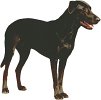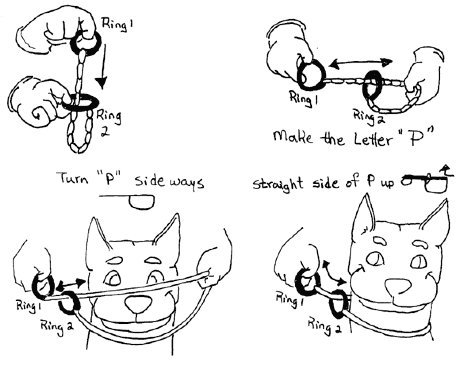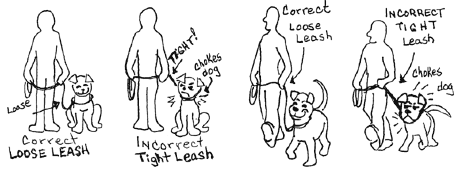

1. A choke or pinch style collar - made of smooth link chain, sized in proportion to your dog. No tags, extra rings or couplers on the collar. When drawn tight, the collar should have not more than two to three inches of extra length. For swift meaningful corrections invest in a hexagon collar on page 70 in your UPCO Catalog. The training collar is your dog's "phone". Absolutely no buckle collars may be used.
2. A leather or cotton web leash - six foot long, (nothing longer or shorter) that is wide enough to be strong, but easily grasped by your hand. No loops (i.e. handles) near the collar, no nylon web, chain, and absolutely no flex (retractable) leashes. The leash is your dog's "phone line."
Before starting training classes, be sure that your dog is "leash trained", i.e.: walks easily on a leash, without fear or fighting. This is called "walkies" and is explained in the first lesson of this course guide. Do not expect to leash train and obedience train your dog at the same time; this is too much for the dog!
The dog learns through your effective use of the collar and leash. Therefore, the collar must be on correctly! Slip the collar together, as per drawing, and then tighten the collar by pulling ring one. Practice on your own arm first. When you release tension, the collar should slacken and slip back into place. Place it on your dog and test again. If the collar does not slacken, you have it on wrong (backwards).

NOTE: Never leave a choke collar on a dog after training is over! It can kill your dog! Attach your leash to ring one (1) of your collar, once it is correctly on the dog. The leash's snap (coupler) should be attached to the ring that goes over the dog's neck... not the ring under the dogs neck. Hold leash with both hands and carry arms down in natural walking positions by your sides. Take up extra leash in your right hand. Leave enough extra for a loose loop between the dog and your left hand. It is the loose loop of the leash between the dog and yourself that is your correcting ability...do not keep the leash and collar tight or you will not be able to correct properly!! The object is to keep the collar slack and the leash loose!!

Correcting of errors during obedience training will be through use of the collar and leash in movements called "jerks". You quickly, firmly, clearly, tighten the tension of the collar and leash and then immediately release so the leash is loose again. At the start of your training course, you will be jerking on the collar and leash continually to keep the dog's attention on you. Use the collar and leash with authority, but do not put more strength into the jerk (snap) than is needed for a firm, clear correction... it does not have to be harsh (unless, your dog is strong and/or stubborn). With puppies and small dogs... tiny, little, light jerks, followed by encouragement and praise, will do. Remember - keep collar slack and leash loose. If you maintain a tight collar and leash, you not only will have no way of correcting errors, you are, also, teaching the dog to pull against the leash!!
Back |
Menu |
Next |